Abstract
This study investigates the relationship between colour and memory. This was investigated via the means of presenting a series of 10 words in two different conditions, using a participant sample of 102 undergraduate Psychology students. The first condition presenting 10 words in black text on a white background, the second condition presenting 10 words in black text on a red background, conducted as a within subjects design. Various previous research in this area of colour and memory suggested that the use of colour, particularly colours such as red would increase levels of attention due to their association with behaviour such as arousal (Kuller, Mikellides, & Janssens, 2009). The two tailed experimental hypothesis for this study states that participants would perform better on the white background memory task. However the findings of this study did not support the experimental hypothesis shown by the use of a T-test which indicated condition one 1 (M=6.95, SD=1.64) and condition 2 (M=6.90, SD=2.18; t(101)=4.434, p < .05 (two-tailed). These findings show a significant difference, that participants performed better on the word recall task for the first condition (black text white background) and poorer on the second condition (black text white background).
Introduction
It is broadly known that colour has influence on human behaviour. This can also include the influence on behaviour of literate individuals, affecting how they encode written words and information as well as influence memory (Hall & Hanna 2004). It is widely known that exposure to different colours has different effects on human behaviour including our capacity to encode information. Memory and the process through which we retrieve encoded information has long been an interest amongst the Psychologology community. Individuals with normal colour perception are able to quickly categorise and encode objects based on their colour. Despite this, the influence that colour has in the process of word recognition and word memory recall is less understood. Images made up of a wide array of colours are found to be better remembered than that of images just made up of a combination of black and white (Wichmann et al 2002). From these findings it has been considered that words on a screen could be better encoded and more accurately recalled if they were presented on a different coloured background rather than a typical white background. However it has been noted by Hall & Hanna (2004) that words are better encoded when presented on a background colour that is greatly contrasted with colour of the text; this finding could be applied to the typically black text found on a white background. However these findings do not specify that the typical black text on a white background are the best colour combination for optimal encoding and recall. In addition to varying contrast of text and background colours playing a role in the difficulty of memory recall, findings from other research indicate that different factors play a role in text background colour and the reader’s ability to perceive the text in a legible manner suggesting that different colours used for text background can influence the legibility of the text (Grecco et al 2008). Therefore it can be assumed that some colours creating lower legibility can slow the encoding process and result in poorer word recall, as greater cognitive input and attention is required to make sense of the less legible text in order to properly encode information. Colour also plays a role in attracting our initial attention (Dzulkifli & Mustafar 2013) which could also influence the process of encoding text information if it is displayed on different coloured backgrounds. When we think of written text we generally think of black text on a white background; having anything other than this presented to us could capture our attention and have the potential better to encode that information or make the text on the different coloured background more memorable. However, just this change in stimuli during the process of reading the text does not necessarily mean that the text is going to be better encoded rather than it just requires more attention.
This present study explores the specific relationship between text background colour and word recall. Based on previous studies conducted on text background colour it is predicted that participants will perform better on the white background condition rather then the red background condition based on the role colour plays in legibility, as previous research suggests that text information is better encoded when higher contrasting colours are used (Hall & Hanna 2004). Furthermore other research into the topic indicates that lower contrasting colours such as black text on a red background in condition two will reduce the legibility of the text thus making it more difficult to encode (Grecco et al 2008) resulting in poorer recall. In world we live in, text is most often displayed as black on a white background common across all aspects of life, so it could also be argued that to process text on an abnormal colour, i.e. anything other than a white background, would require greater attention and impede our ability to encode that information. The aim of this study was to investigate the performance of undergraduate students on two different memory tasks, measuring the number of correct words recalled for each of the two memory tasks. For this study the two tailed hypothesis states that participants would perform better on the white background memory task.
Method
Design
This study was conducted using a within participants design. The independent variable that was manipulated was the colour of the background surrounding each word, i.e. condition one each word was displayed on a white background, and condition two each word was displayed on a red background, the text of all words in both conditions were displayed in black text. The dependent variable was the number of correct words recalled by each participant for the two conditions. This was recorded in a written format by each participant, and collected at the end of the study. This study was conducted only using two conditions, with no control condition. For this study the two tailed hypothesis states that participants would perform better on the white background memory task. The null hypothesis presents that there will be no significant difference between the results of the two conditions suggesting that colour plays no role in the results of memory recall.
Participants
The participants used in this study were recruited by the means of opportunity sampling. 14 males and 88 females making a total of 102 all of which were undergraduate Psychology students.
Materials
The only technical materials used during this study were a screen and projector as a means of displaying the stimuli of each condition and counting subtractor tasks.
Procedure
During this study, participants gave informed consent to take part in a word memory task. Participants were tested in two separate sessions. One being from 9am to 10am, the other during a late morning session from 11am to 12pm. In both sessions participants were verbally briefed by university staff and gave written consent to take part as a learning activity. Participants were also informed of a deadline date for data withdrawal, should they decide to withdraw their data from the study. Participants then performed a word recall task under two conditions. In condition one, ten words were projected onto a screen in black text on a white background for three second intervals. A counting- based distractor task was then initiated for thirty seconds. This involved subtracting 17 from 2018, to be performed verbally until instructed to stop at the end of the thirty seconds. Participants then performed free recall for one minute, recalling as many words as possible that had been presented in condition one. The number of words each participant recalled correctly was then recorded. then followed, which involved a list of ten words being presented in black text on a red background each for three second intervals. A second counting-based distractor task was then administered for thirty seconds which involved subtracting 13 from 1990 which was to be performed verbally until instructed to stop. (see Appendix 2). Prior to the stimuli being shown to the participants, no trial runs were conducted on the participants.
Results
Descriptive statistics
102 undergraduate psychology students took part in the study, 14 male and 88 female. The standard deviation for correctly recalled words for condition one (the black text on white background) showed a low variation about the mean (M=6.95, SD=1.64) and condition two (black text on red background) (M=6.90, SD=2.18). Both Histograms indicate that the data was normally distributed distributed and that parametric assumptions were met. (See appendix 1)
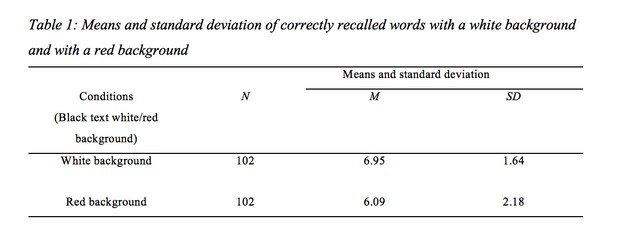
Inferential statistics
A paired subjects t-test was conducted (See appendix 1) to compare the number of correct words recalled for the two conditions. There was a significant difference between the correct number of words recalled for condition one (M=6.95, SD=1.64) and condition two (M=6.90, SD=2.18; t(101)=4.434, p < .05 (two-tailed). The number of correct words recalled for condition one (black text on a white background) was significantly greater than that of condition two (black text on red background.).
**Discussion **
The aim of this study was to investigate the performance of undergraduate students on two different memory tasks, measuring the number of correct words recalled for each of the two memory tasks. The findings of this study supports the hypothesis that participants would score better on the white background memory task.
Existing research further supports these findings on the influence of colour on memory and the effect of colour on word recall (Hall & Hanna 2004). This further supports research that people better encode text information when text is displayed using high contrast colours, which in this case was black text on a white background as used in condition one.
There were various weaknesses in the methodology of this study. These limitations mainly exist in the selection of the participant sample: although the participant sample was made up completely of undergraduate psychology students no consideration was made for the differences of performance between male and female participants. As both male and female human beings are biologically different so it could be argued one gender may score better on average on one given condition than another. For example, Kuller, Mikellides & Janssens (2009) found that colours such as red may increase arousal and it has been noted that males are visually stimulated more easily than females (Levin et al 1998), which in turn presents the argument that male participants may perform better on the second condition of the word memory recall task. However the methodology of this study did not account for participants’ genders making it impossible to examine different performances of the different memory recall tasks. In addition to the methodological problem of gender in this study, no measures had been taken prior to the study to ensure all participants taking part had the same standard of vision and colour perception. It could be assumed that participants taking part in the study with any kind of visual impairment, or impairment of colour perception could have reduced the validity of the findings of this study as it would be likely that any visually impaired participants would have found it more difficult to encode the words presented in both conditions. Similarly, the participants were arranged across the room at varying distances from the screen where the stimulus was displayed, thus some participants may have performed better on either task depending upon their location within the room where the study took place. A further limitations in the methodology of this study is that participants were not tested for the same level of reading ability, for example any dyslexic participants may have found it more difficult to encode longer or more complicated words on either condition than a participant with better literacy abilities. This would have further obscured the findings of this study, by there likely being lower recall scores in both conditions by participants with dyslexia for any complex words, showing little difference across the two conditions.
As a whole the findings of this study further support previous research giving supporting evidence that participants encode text information better when text information is presented as high contrasting colours of black text on a white background. In addition the notion that different colours being used as text backgrounds
These findings can be applied to further support that text presented in black and white is a better way to present written information as findings indicate that text information is more difficult to recall when presented in different colours than black and white, specifically as black text on a red background in this study. However this raises further questions as to how the use of a broader array of colours could influence encoding visual text information, especially as there are other high contrasting colours other than just black and white.
Dzulkifli, M. A., & Mustafar, M. F. (2013). The influence of colour on memory performance: A review. The Malaysian journal of medical sciences: MJMS, 20(2), 3.
Greco, M., Stucchi, N., Zavagno, D., & Marino, B. (2008). On the portability of computer-generated presentations: The effect of text-background color combinations on text legibility. Human factors, 50(5), 821-833.
Hall, R. H., & Hanna, P. (2004). The impact of web page text-background colour combinations on readability, retention, aesthetics and behavioural intention. Behaviour & information technology, 23(3), 183-195.
Herlitz, A., Nilsson, L. G., & Bäckman, L. (1997). Gender differences in episodic memory. Memory & cognition, 25(6), 801-811.
Kuller, R., Mikellides, B., & Janssens, J. (2009). Color, arousal, and performance – A comparison of three experiments. Color Research and Application, 34, 141-152.
Levin, J. M., Ross, M. H., Mendelson, J. H., Mello, N. K., Cohen, B. M., & Renshaw, P. F. (1998). Sex differences in blood-oxygenation-level-dependent functional MRI with primary visual stimulation. American Journal of Psychiatry, 155(3), 434-436.
Wichmann, F. A., Sharpe, L. T., & Gagenfurtnet, K. R. (2002). The contributions of color to recognition memory for natural scenes. Journal of Experimental Psychology: Learning Memory, and Cognition, 28, 509-520.

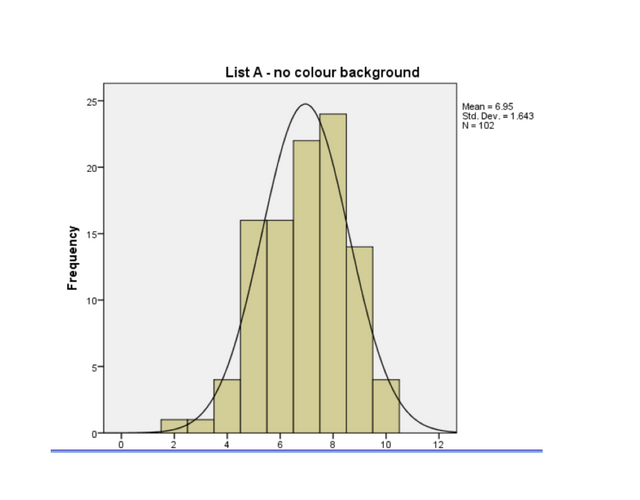
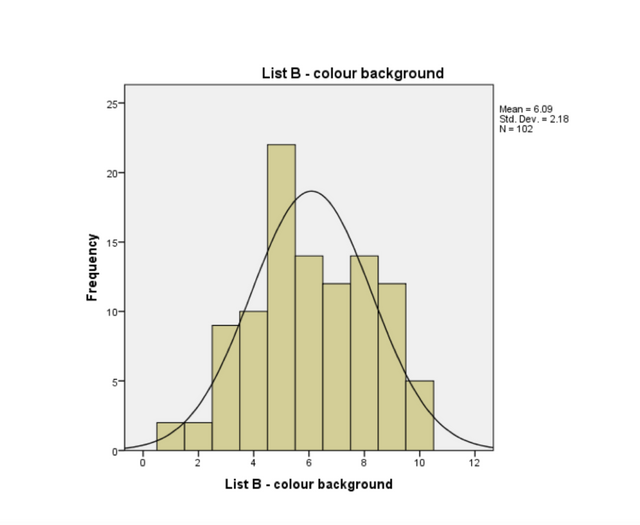
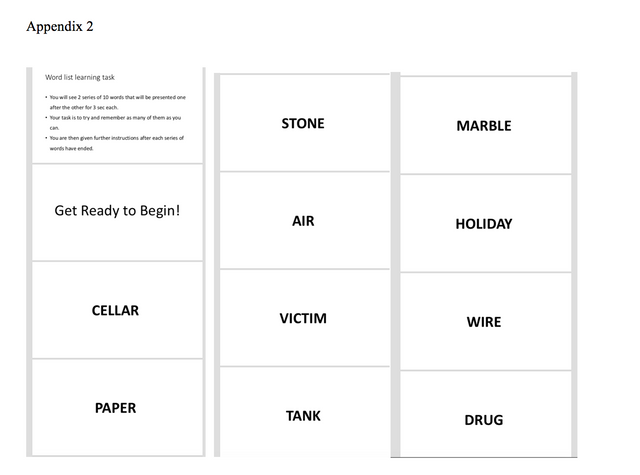
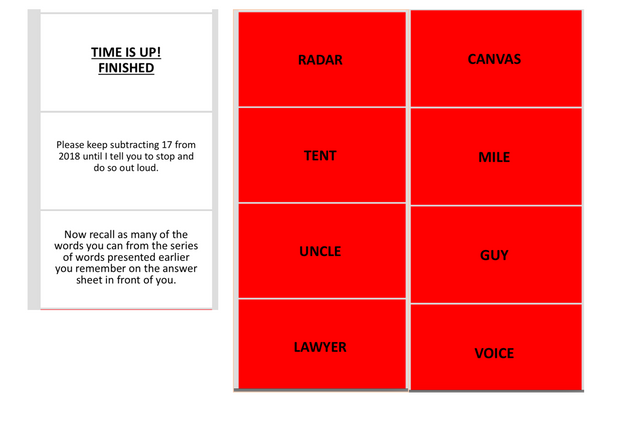
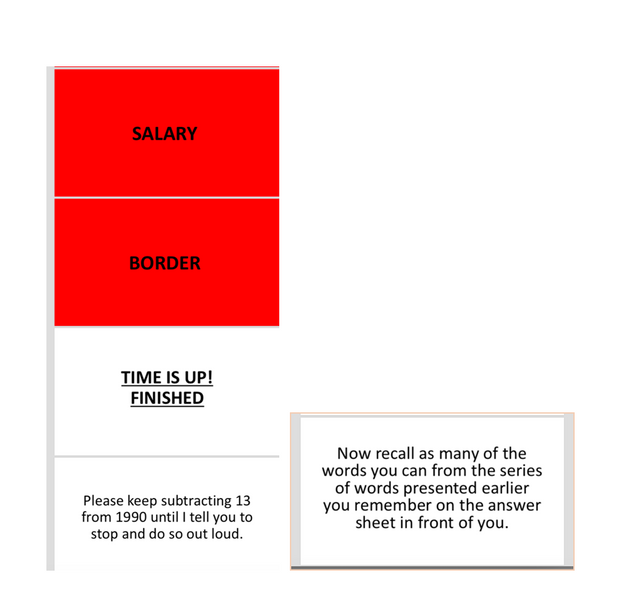
This is what I do when I'm not training. It's a real pain in the backside.
Please, write a comment at https://steemit.com/runneroftheweek/@runningproject/runner-of-the-week-the-steem-running-project-ed9-season-2-powered-by-actifit , you will be upvoted by ACTIFIT
Downvoting a post can decrease pending rewards and make it less visible. Common reasons:
Submit
Downvoting a post can decrease pending rewards and make it less visible. Common reasons:
Submit